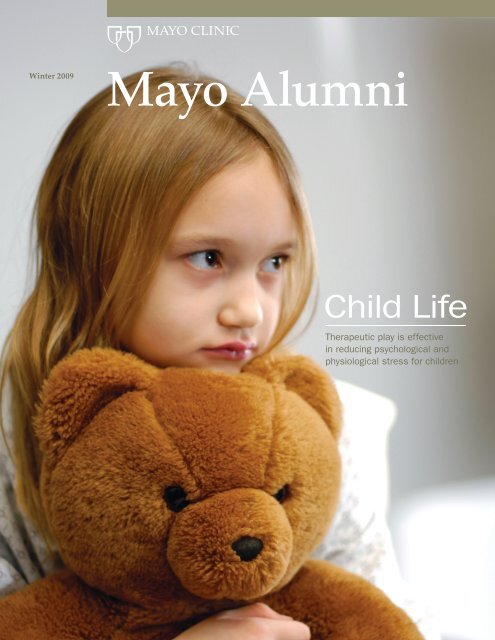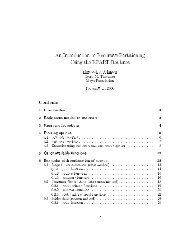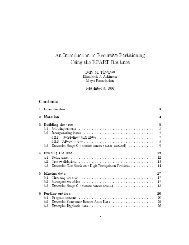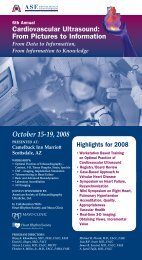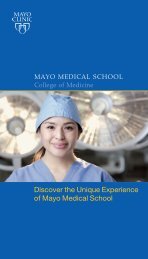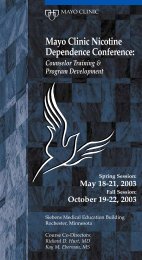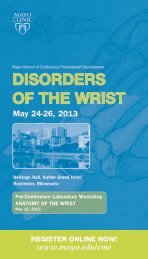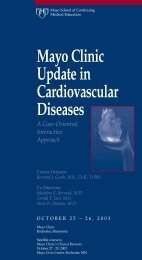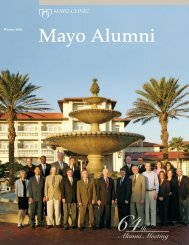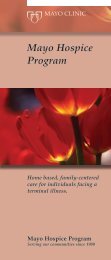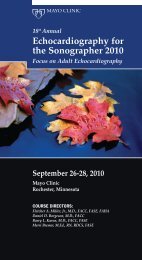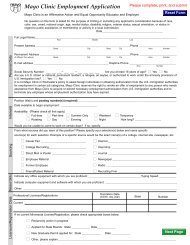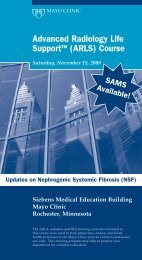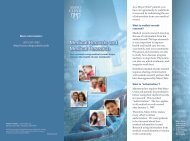Winter 2008-2009 - Mayo Clinic
Winter 2008-2009 - Mayo Clinic
Winter 2008-2009 - Mayo Clinic
You also want an ePaper? Increase the reach of your titles
YUMPU automatically turns print PDFs into web optimized ePapers that Google loves.
<strong>Winter</strong> <strong>2009</strong><br />
<strong>Mayo</strong> Alumni<br />
Child Life<br />
Therapeutic play is effective<br />
in reducing psychological and<br />
physiological stress for children
<strong>Mayo</strong> Alumni<br />
<strong>Winter</strong> <strong>2009</strong><br />
Features<br />
2 The needs of the patient come first …<br />
regardless of their age<br />
Child Life specialists at <strong>Mayo</strong> <strong>Clinic</strong> help ensure pediatric patients’<br />
needs are met, including play. It’s not all fun and games — research<br />
indicates that therapeutic play is effective in reducing psychological and<br />
physiological stress for children facing medical challenges. Child Life<br />
staff combine pediatric science with face-to-face contact to ensure<br />
children are prepared for medical experiences.<br />
10 Center for Tobacco-Free Living<br />
<strong>Mayo</strong> <strong>Clinic</strong>’s new Center for Tobacco-Free Living was designed to<br />
provide hope to people who have struggled with trying to stop smoking.<br />
Through guilt-free education and access to <strong>Mayo</strong>’s Nicotine Dependence<br />
Center treatment services, the new center hopes to attract some of the<br />
more than 600 patients a day who pass its space on the 18th floor of the<br />
Gonda Building.<br />
16 Leadership Council for Alumni Philanthropy<br />
One of seven leadership councils supporting The Campaign for <strong>Mayo</strong><br />
<strong>Clinic</strong>, the Leadership Council for Alumni Philanthropy has a goal to<br />
secure $28 million in alumni gifts by the end of <strong>2009</strong>. Educating alumni<br />
about <strong>Mayo</strong>’s funding needs in order to maintain its leadership position<br />
in health care is essential to the council’s success.<br />
20 New emergency cardiac “super” drug<br />
<strong>Clinic</strong>ians and researchers around the world are closely watching<br />
results of clinical trials of CD-NP, a chimeric protein that has therapeutic<br />
potential to treat acute and chronic congestive heart failure and improve<br />
renal function in patients undergoing heart surgery. <strong>Mayo</strong> <strong>Clinic</strong><br />
physician-scientists John Burnett, M.D., and Ondrej Lisy, M.D., Ph.D.,<br />
developed the new drug.<br />
<strong>Mayo</strong> Update<br />
22 News Briefs<br />
22 Staff News<br />
23 Obituaries
G<br />
iven the current national and international economic crisis,<br />
we have invited <strong>Mayo</strong>’s president and CEO, Denis Cortese, M.D.,<br />
to comment on the organization’s short- and long-term responses<br />
to the situation.<br />
<strong>Mayo</strong> <strong>Clinic</strong>’s financial health<br />
The challenges facing health care today are great, and they’re not<br />
likely to subside, even when our nation’s economy rebounds.<br />
Although we did not foresee the current global economic crisis,<br />
we did anticipate major economic challenges in health care based on<br />
Medicare reimbursement rates and the number of people reaching<br />
retirement age.<br />
In the last few years we have taken a number of steps to improve<br />
<strong>Mayo</strong>’s financial outlook including: fully funding our pension plan,<br />
building our endowment, conducting a capital campaign to sustain<br />
our education and research missions, and launching our <strong>Mayo</strong> <strong>Clinic</strong><br />
Health Policy Center to influence health care reform. This has put us<br />
in a better position to deal with the current crisis, but increasingly the<br />
economic downturn has underscored the importance of our ability to<br />
adapt and change.<br />
Short- and long-term responses<br />
We’re taking a number of immediate actions to improve our short-term<br />
financial outlook, including increasing access for patients who meet our<br />
triage criteria, aggressively managing expenses, delaying some capital<br />
projects and reducing planned capital expenditures, and fast-tracking<br />
projects that have potential for the greatest positive impact.<br />
For the long term, our strategic plan continues to be our guide.<br />
Our goal for <strong>2009</strong> and beyond includes transformational change that<br />
will allow us to increase the value of our care for our patients. We will<br />
accomplish this by relentlessly pursuing quality, driving out waste,<br />
improving our efficiency and effectiveness by integrating across the<br />
enterprise, developing new and innovative models of care, and<br />
evolving to meet the needs of tomorrow’s patients through<br />
individualized medicine.<br />
Best regards,<br />
About the cover<br />
<strong>Mayo</strong> <strong>Clinic</strong> formally established<br />
a Child Life Program in 1988 to<br />
facilitate the emotional and<br />
physical well-being of our<br />
youngest patients.<br />
Denis Cortese, M.D.<br />
President and CEO<br />
www.mayo.edu/alumni | 1
2 | <strong>Mayo</strong> Alumni <strong>Winter</strong> <strong>2009</strong>
Child Life<br />
Child Life specialists help ensure pediatric patients’ needs are met, including playtime<br />
eds are met includi<br />
time<br />
P<br />
hilip Fischer, M.D., medical director of <strong>Mayo</strong><br />
Eugenio Litta Children’s Hospital, says the patient<br />
care he provides is most effective when it’s part of a team.<br />
“Coordinating my care with that provided by the Child Life<br />
team makes our patient care better,” says Dr. Fischer, a<br />
professor of pediatrics in the College of Medicine.<br />
A central goal of pediatric health care is to facilitate the<br />
emotional and physical well-being of children in the hospital.<br />
Research indicates that therapeutic play is effective in<br />
reducing psychological and physiological stress for children<br />
facing medical challenges.<br />
“What looks like play to a child is actually therapy,”<br />
says Dr. Fischer. “Child Life staff combine the best of<br />
pediatric science with fun and practical face-to-face contact.<br />
They have a true understanding of child development<br />
and techniques of play.”<br />
Child Life staff augment medical care in these ways:<br />
• Ease pediatric patients’ fears<br />
• Teach and prepare children for medical and<br />
surgical procedures<br />
• Help children and families cope with the stress<br />
of being in the hospital<br />
• Advocate for family involvement in the<br />
hospital experience<br />
• Engage children and families in activities and<br />
the treatment experience<br />
• Support families during grief and bereavement<br />
• Provide information and resources<br />
For inpatients at <strong>Mayo</strong>’s children’s hospital — the <strong>Mayo</strong><br />
Eugenio Litta Children’s Hospital located within Saint Marys<br />
Hospital, Child Life specialists work closely with physicians,<br />
nursing staff and other team members, including parents,<br />
to determine and meet patients’ needs. In the pediatric<br />
emergency room, Child Life specialists are present 10 hours<br />
a day to assist patients, nurses, physicians and other<br />
team members.<br />
“A hospital stay can be frightening and traumatic for<br />
a child who may be away from family members and other<br />
comforts of home,” says Randy McKeeman, director of<br />
Child Life Services at <strong>Mayo</strong> <strong>Clinic</strong> and a certified child life<br />
specialist. “Children in the hospital may be lonely and lack<br />
stimulation. Research in recent years shows that stress can be<br />
a major inhibitor in the ability of a patient to heal and stay<br />
“What looks like play to<br />
a child is actually therapy.”<br />
healthy. Child Life specialists help children effectively<br />
manage stress and, hopefully, heal faster. Research shows<br />
that the long-term implications of a negative medical<br />
experience can be profound — post-traumatic stress,<br />
increased fears and decreased cooperation — for pediatric<br />
patients not effectively prepared for a medical experience.”<br />
During therapeutic play, children are encouraged to<br />
ask questions and express feelings about their fears and<br />
concerns. Child Life staff can elicit valuable information<br />
while helping young patients learn what to expect from<br />
medical procedures.<br />
All in a day’s work: Dr. Philip Fischer (left), medical director<br />
of <strong>Mayo</strong> Eugenio Litta Children’s Hospital, works closely<br />
with Child Life staff, including (from left) Jane Heser,<br />
Randy McKeeman and Carli Kramer.<br />
www.mayo.edu/alumni | 3
Sean Trewin (left) with his family, including<br />
sister Abby and parents Patrick and Karen,<br />
and (above) when he was treated for Burkitt’s<br />
lymphoma at <strong>Mayo</strong> <strong>Clinic</strong>.<br />
“Several studies have shown that therapeutic play is<br />
effective in decreasing anxiety and fears for children,” says<br />
McKeeman. “Children not only showed greater cooperation<br />
during stressful procedures, but they also were more willing<br />
to return to the hospital for further treatment. Other studies<br />
show physiological benefits from therapeutic play, including<br />
lower blood pressure and pulse rate, less palm sweating,<br />
and a shorter time between surgery and first voiding.<br />
<strong>Mayo</strong> <strong>Clinic</strong>’s primary value is that the needs of the<br />
patient come first, and Child Life services support that.”<br />
Patients’ perspective<br />
Sean’s story<br />
Four-year-old Sean Trewin described the effect of anesthesia<br />
administered prior to his bone marrow biopsies as “hard<br />
snow that makes my head feel funny before I go to sleep.”<br />
His mother, Karen, relayed that information to a Child Life<br />
specialist at <strong>Mayo</strong> Eugenio Litta Children’s Hospital, who<br />
speculated that the anesthesia might be acting too quickly.<br />
The Child Life specialist talked to Sean’s anesthesiologist<br />
about slowing down the rate at which the medication was<br />
administered. Sean noticed the difference and told his<br />
mother he felt better.<br />
“The Child Life specialist advocated for us and made<br />
Sean’s treatment easier,” says Karen Trewin, who lives in<br />
Decorah, Iowa. “They were a great resource for us at a very<br />
trying time in our life. Child Life services showed us that<br />
<strong>Mayo</strong> was there for us in all aspects of the patient experience,<br />
in all facets of our care.”<br />
Sean, now 13, had Burkitt’s lymphoma. When his<br />
parents received his diagnosis, his mother was so upset that<br />
she fled the room. Jane Heser, a certified child life specialist,<br />
comforted her in the hallway.<br />
“I was pregnant with my daughter at the time, and it<br />
was all so overwhelming,” says Karen Trewin. “Sean’s first<br />
hospitalization was eight weeks long. I alternated between<br />
being frantic and hopeful. Jane and her colleagues were as<br />
much a comfort and help to my husband, Patrick, and me as<br />
they were to Sean.<br />
“They told me it was important for Sean to be around<br />
other people and have stimulating activities, and also<br />
important for us to take a break. The staff did activities with<br />
Sean on Easter so we could go out to dinner with my parents,<br />
who were visiting.”<br />
4 | <strong>Mayo</strong> Alumni <strong>Winter</strong> <strong>2009</strong>
Will’s story<br />
When 6-year-old Will Canan was diagnosed with a cancerous<br />
brain tumor, a Child Life specialist helped his parents, Liz<br />
and Tom, determine how to explain the condition to Will and<br />
his sister, Katherine, then 8.<br />
“Katherine asked me questions like, ‘Is cancer<br />
contagious?’ and ‘Is Will going to die?’” says Liz Canan.<br />
“The Child Life specialist assured me these questions were<br />
normal and helped me answer them. Within 12 hours of<br />
Will’s diagnosis, he was undergoing an eight-hour surgery.<br />
We were emotionally and physically exhausted, and Will was<br />
quite ill afterward. Child Life staff planned activities and<br />
crafts for Katherine and took her to the playroom. Siblings<br />
are often forgotten when they have a sick brother or sister in<br />
the hospital. Katherine enjoyed this time, thanks to the help<br />
from Child Life staff. They gave her undivided attention,<br />
which we couldn’t give her then. It was an incredible support<br />
to our family when we most needed it.”<br />
During a recent visit to the pediatric subspecialty clinic,<br />
Will ran into a friend who also has cancer. “As the boys<br />
played electronic games, Will explained the particulars of a<br />
treatment the other boy would be having — a treatment Will<br />
previously had,” says Liz Canan. “He used language he<br />
learned from Child Life staff. The conversation was so<br />
casual and normal. Child Life staff helped ease Will’s<br />
anxieties when he had procedures, and Will helped ease a<br />
friend’s anxieties. I consider that a tribute to those at <strong>Mayo</strong><br />
who have provided his care. They included him in what<br />
was going on with his illness and, as a result, he has been<br />
an easy patient. He has handled his illness with maturity<br />
and grace, free of fear.”<br />
Will Canan (above) was treated for a cancerous brain tumor at <strong>Mayo</strong> <strong>Clinic</strong>.<br />
His family includes parents Tom (left) and Liz (right) and sister Katherine.<br />
www.mayo.edu/alumni | 5
Rioghna’s story<br />
When Rioghna Pittock had surgery to reverse an ostomy<br />
she’d had since age 2, her siblings, Hannah, 10, and John, 8,<br />
didn’t realize how sick their 5-year-old sister would look<br />
when they visited her in the hospital.<br />
“Everyone in the family was very excited as Rioghna<br />
kissed her siblings goodbye the morning of the surgery,” says<br />
their mother, Siobhan Pittock, M.D., a consultant in Pediatrics<br />
and Endocrinology and instructor in pediatrics at <strong>Mayo</strong><br />
<strong>Clinic</strong>. “The other kids expected Rioghna to be just as excited<br />
as she was before the surgery. They were quite shocked when<br />
she appeared tired and pale. Child Life staff distracted them<br />
with toys and crafts so they had time to adjust.”<br />
“It’s never a good situation when a child is in the<br />
hospital. I’m so glad <strong>Mayo</strong> has tremendous Child Life<br />
services because not every hospital does,” says Dr. Pittock.<br />
“It was a good experience for me to be on the side of<br />
benefiting from Child Life services because I promote them<br />
to my patients. It’s good to see firsthand that what I tell<br />
patients and their families is so true. Child Life staff are<br />
excellent extenders of the care we provide. As far as I’m<br />
concerned, Child Life services are a vital, essential part of<br />
pediatric care at <strong>Mayo</strong>. They notice things about family<br />
dynamics that providers may not notice, and the children<br />
sometimes tell them things they don’t tell us.”<br />
Rioghna Pittock when she was in the hospital (above)<br />
and today (left), with her family: (clockwise from top<br />
left) Dr. Sean Pittock, a <strong>Mayo</strong> <strong>Clinic</strong> neurologist;<br />
Dr. Siobhan Pittock; baby brother Fionn; brother<br />
John; and older sister Hannah.<br />
6 | <strong>Mayo</strong> Alumni <strong>Winter</strong> <strong>2009</strong>
Providers’ perspective<br />
Jane Heser’s story<br />
“I try to see things through the child’s eyes,” says Jane Heser,<br />
a Child Life specialist. “I consider myself a teacher who helps<br />
pediatric patients understand what’s going on, what pieces of<br />
equipment are for, what’s required of them and how they can<br />
cope with it all. We use simple, honest, developmentally<br />
appropriate language, and respect kids as intelligent,<br />
sensitive learners.”<br />
Heser tapes tubes on a doll to show a child the purpose<br />
of different medical tubes. She engages a mother and 2-yearold<br />
in a game of peekaboo to coax the child to wear an<br />
oxygen mask. She distracts a toddler with a spinning toy<br />
while blood is drawn. She leads Halloween trick-or-treaters<br />
on a parade through the main level of the hospital. She helps<br />
patients learn about medical procedures in the hospital’s<br />
medical play area, complete with a small X-ray box.<br />
Her job isn’t all fun and games. She helps a teenager plan<br />
his funeral. She helps parents make plaster hand molds and<br />
handprints of their terminally ill children. She helps make<br />
memory boxes for parents to preserve precious reminders of<br />
their children, including locks of hair. She helps parents and<br />
children with difficult conversations about death and dying.<br />
Heser shares a story about four siblings. One sister was<br />
having a bone marrow transplant, and the other was the<br />
donor. Heser worked with the sisters to show them how<br />
medication would be administered during surgery and how<br />
the transplant would happen. The transplant patient never<br />
lost her spirit during her monthlong hospitalization, says<br />
Heser, in part due to visits with her siblings.<br />
“Those visits were the highlight of her day,” says Heser.<br />
“I planned activities and crafts for them, and they were eager<br />
to participate. It was wonderful to see how important togetherness<br />
was for this family and this patient. A family should<br />
have the opportunity to do what it normally does, even when<br />
a member is in the hospital.”<br />
“I’m so glad <strong>Mayo</strong> has tremendous<br />
Child Life services because not<br />
every hospital does.”<br />
<strong>Mayo</strong> <strong>Clinic</strong> was ranked as one of America’s Best Children’s<br />
Hospitals by U.S. News & World Report (June 9, <strong>2008</strong>). <strong>Mayo</strong><br />
was ranked in three specialties: neurology and neurosurgery,<br />
digestive disorders, and heart and heart surgery. <strong>Mayo</strong> <strong>Clinic</strong><br />
has been ranked as a top pediatric hospital every year since<br />
U.S. News & World Report began ranking hospitals.<br />
www.mayo.edu/alumni | 7
Carli Kramer’s story<br />
Carli Kramer’s interest in Child Life services stems from<br />
an experience as a teen growing up in Rochester. A friend<br />
was treated for cancer at <strong>Mayo</strong> <strong>Clinic</strong>, and Kramer noticed<br />
how Child Life services supported the family. She says<br />
pursuing a career in the profession was “a small way to<br />
honor my friend.”<br />
Kramer works in the Emergency Department. “We<br />
move at a quick pace, meeting families and assessing their<br />
needs in a short time,” she says. “We prepare kids and<br />
families for tests, procedures and surgeries and help them<br />
through it. We do a lot with play and distraction, getting<br />
even the youngest kids through tough procedures like<br />
stitches and IVs.<br />
Kramer tells about a young patient who had nursemaid’s<br />
elbow. “She was in hysterics. I tried for 15 minutes to comfort<br />
her,” says Kramer. “Then I brought in ‘The Little Mermaid’<br />
DVD. The girl immediately stopped crying and chattered<br />
nonstop about the characters she loved. She was treated<br />
without a fuss. Sometimes simple things or just the right<br />
familiar item make all the difference.”<br />
The hardest part of the job, says Kramer, is when a child<br />
dies. “It is one of the most humbling parts of what I do,” she<br />
says. “A little boy died, and his parents needed time to say<br />
goodbye. His 7-year-old brother was outside the room. I<br />
asked him if he wanted to talk or do something. He spotted<br />
Guitar Hero nearby and said he wanted to play. He showed<br />
me how to play, and we laughed about my mistakes. I helped<br />
him check out of what was going on in a healthy way. Kids<br />
work through things differently, and play is a huge part of<br />
it. It’s the ‘business of childhood’ and most often your<br />
best way in.”<br />
“Play teaches children how<br />
to handle the world and is<br />
the primary way in which they<br />
relate to their environment.”<br />
8 | <strong>Mayo</strong> Alumni <strong>Winter</strong> <strong>2009</strong>
Dr. Philip Fischer and his family hosted Harka (fourth from left) when she had heart surgery at <strong>Mayo</strong> <strong>Clinic</strong> four years ago.<br />
Dr. Fischer visited her family (pictured) at their home on the outskirts of Ulaan Bataar, Mongolia’s capital city in March <strong>2008</strong>.<br />
Dr. Fischer’s story<br />
Dr. Fischer participates in organizations that bring pediatric<br />
patients from third-world countries to <strong>Mayo</strong> <strong>Clinic</strong> for<br />
medical care. The Fischer family has hosted some patients<br />
and families.<br />
“Some of these patients are from countries where<br />
physicians don’t necessarily explain medical things to them,<br />
and families aren’t accustomed to being involved in decision<br />
making,” he says. “Child Life staff are a bridge between<br />
medical staff and these patients and their families.”<br />
Jane Heser, a Child Life specialist, worked with one<br />
patient who was staying with the Fischers. “Jane let him<br />
dress up like a doctor to teach him what to expect in the<br />
hospital,” says Dr. Fischer. “At home, during his recovery, he<br />
dressed up like the doctor and I was his patient. Hands-on<br />
activity like this is important for children’s understanding<br />
and can make the difference between a miserable patient<br />
experience and a simple, easy experience. It’s amazing how<br />
fear can be erased, optimism can be restored, spinal taps<br />
can be less traumatic, stitches can hurt less, and nasogastric<br />
tubes can be swallowed more easily.<br />
“Children from all cultures play. It is essential to<br />
human development. Research shows that play has a<br />
positive effect on cognitive and social development,<br />
particularly when adults participate in play with children.<br />
Play teaches children how to handle the world and is the<br />
primary way in which they relate to their environment.”<br />
www.mayo.edu/alumni | 9
No lectures, no blaming, no judging<br />
Center for Tobacco-Free Living educates and motivates tobacco users to seek help<br />
I<br />
n November <strong>2008</strong>, <strong>Mayo</strong> <strong>Clinic</strong> opened its Center for<br />
Tobacco-Free Living on the 18th floor of the Gonda<br />
Building. Part of the Nicotine Dependence Center, the new<br />
1,000-square-foot facility features interactive displays — The<br />
Anatomy of Addiction; Smoke and Mirrors: The Truth Behind<br />
Big Tobacco; The Science of Quitting; and Supporting a<br />
Tobacco-Free World.<br />
The Center for Tobacco-Free Living was intentionally<br />
located on the same floor as the Annenberg Pulmonary<br />
Medical Center. Many pulmonary patients use tobacco, and<br />
some of these 600-plus patients a day walk past the new space<br />
on their way to appointments. For those who stop by, tobacco<br />
treatment specialists are available to answer questions and<br />
schedule consultations.<br />
“This center is designed to provide hope to people<br />
who have struggled with trying to stop smoking, provide<br />
information about why quitting is difficult and provide<br />
easy access to tobacco dependence treatment services,” says<br />
Richard Hurt, M.D., director of the Nicotine Dependence<br />
Center at <strong>Mayo</strong> <strong>Clinic</strong>, a consultant in Internal Medicine<br />
and professor of medicine.<br />
“Few people aren’t aware that tobacco is harmful, but<br />
those who use it often feel ashamed and stigmatized,” says<br />
Michael Burke, Ed.D, coordinator of Nicotine Dependence<br />
Center treatment programs. “This new facility helps patients<br />
and their loved ones understand the powerful biological<br />
component of tobacco dependence, and provides information<br />
about proven, effective treatments. The new center also<br />
includes compelling information about how tobacco has been<br />
marketed and exciting information about genetic research<br />
into nicotine addiction using a zebrafish model.” (see page 14)<br />
Smoke and Mirrors: The Center for Tobacco-Free Living features<br />
information detailing how tobacco companies market a product that<br />
contributes to the leading cause of preventable deaths in the United States.<br />
10 | <strong>Mayo</strong> Alumni <strong>Winter</strong> <strong>2009</strong>
The Tobacco-Free Living center’s primary goal is to<br />
support those seeking treatment for tobacco dependence<br />
by providing:<br />
• Research-based information about the biological basis<br />
for tobacco dependence and why some people have more<br />
difficulty quitting tobacco than others<br />
• Personal stories from patients who became tobacco-free<br />
• Information about the most effective treatment methods<br />
• Easy access to treatment<br />
All information is presented nonjudgmentally. “People<br />
who use tobacco don’t want lectures,” says Tom Gauvin, a<br />
counselor in the Nicotine Dependence Center. “They have<br />
already heard about the dangers of tobacco, and they may<br />
feel ashamed about their lack of success in quitting. By<br />
using the disease model to help patients understand tobacco<br />
dependence, we alleviate the guilt and shame and increase<br />
the chances of success for these individuals.<br />
“The Center for Tobacco-Free Living is intended to be a<br />
safe environment in which tobacco users can be supported<br />
and become engaged in the possibility of treatment. The<br />
straightforward, educational, positive tone is designed to<br />
excite and encourage people in their fight against tobacco.<br />
Ideally, of course, the center is an accessible clinical entry<br />
point for treatment in our Nicotine Dependence Center,<br />
but we want people to seek effective treatment anywhere.”<br />
Sheila Stevens, coordinator of education programs<br />
at the Nicotine Dependence Center, says that tobacco<br />
dependence treatment is underutilized. “More than<br />
40 million people in the United States smoke,” she says.<br />
“Most want to stop but, without treatment, only 3 percent to<br />
Grand opening: (from left to right) Glenn Forbes, M.D., CEO of <strong>Mayo</strong><br />
<strong>Clinic</strong> in Rochester; Andrew Limper, M.D., chair of the Department of<br />
Pulmonary and Critical Care Medicine; Richard Hurt, M.D., director<br />
of the Nicotine Dependence Center; and Denis Cortese, M.D.,<br />
president and CEO of <strong>Mayo</strong> <strong>Clinic</strong>, opened the Center for Tobacco-<br />
Free Living on Nov. 20, <strong>2008</strong> — the date of the American Cancer<br />
Society’s 33rd annual Great American Smokeout.<br />
5 percent of quit attempts are successful. Many people don’t<br />
understand that treatment greatly increases their chances of<br />
successfully quitting. If someone has diabetes, a combination<br />
of education and medication helps them manage their illness.<br />
If the first effort does not succeed, medication is changed,<br />
more counseling is provided and the health care team keeps<br />
working with the patient. That doesn’t often happen with<br />
smoking. Patients get lectured, and their willpower is<br />
questioned. Our counselors work hard to develop effective<br />
partnerships with patients without lecturing or blaming.“<br />
The Nicotine Dependence Center provides outpatient,<br />
residential and hospital services. Many patients in the residential<br />
program have tried other types of treatment without<br />
success. <strong>Mayo</strong>’s residential program has a 52 percent success<br />
rate for one year after treatment. Among outpatients, the<br />
The Anatomy of Addiction: This display in the Center for Tobacco-Free Living shows how addiction to nicotine occurs.<br />
Cigarettes rapidly deliver a large amount a highly addictive substance, which causes changes in the brain. These changes<br />
cause craving and withdrawal.<br />
www.mayo.edu/alumni | 11
success rate is 28 percent after a year. Some patients who are<br />
hospitalized at <strong>Mayo</strong> <strong>Clinic</strong> for another reason are treated<br />
simultaneously for tobacco use. Approximately 32 percent of<br />
those patients are tobacco-free one year later. This compares<br />
with the average success rate of 3 percent to 5 percent for<br />
people who try to quit tobacco use without treatment.<br />
“We’re proud of our success, but we’re relentless in the<br />
pursuit of new ways to help patients,” says Ivana Croghan,<br />
Ph.D., coordinator of research programs at the Nicotine<br />
Cigarette smoking accounts for<br />
90 percent of lung cancer cases.<br />
Dependence Center and an associate professor of medicine.<br />
“We have conducted more than 180 research studies in the<br />
last 20 years, and we try to quickly translate what we learn<br />
into better patient care. We have been instrumental in<br />
testing many of the current treatments, including nicotine<br />
replacement products — patches, gum, inhaler, nasal spray<br />
vaccine, lozenges; bupropion, varenicline, gabapentin, herbal<br />
medication and combinations of medications. We have<br />
worked with various forms of tobacco dependence, including<br />
chewing tobacco; different types of users, including<br />
adolescents, young adults, adults and Alaskan natives; and<br />
concurrent medical conditions including ADHD, COPD,<br />
cancer and alcoholism.”<br />
Nicotine Dependence Center<br />
<strong>Mayo</strong> <strong>Clinic</strong>’s Nicotine Dependence Center was one of the<br />
first in the country to focus exclusively on treating patients<br />
who have tobacco dependence. Since 1988 when it opened,<br />
the center has treated more than 40,000 patients. Treatment<br />
usually combines counseling and medication. Specialists<br />
trained in motivational interviewing help patients build<br />
upon their strengths to succeed.<br />
An eight-day residential treatment program is effective<br />
with patients who have tried other methods without success.<br />
Education<br />
The Nicotine Dependence Center has educated more<br />
than 8,500 health care professionals about evidence-based<br />
treatment. Participants in these education programs have<br />
included physicians, nurse practitioners, physician<br />
assistants, dentists, psychologists, chemical dependency<br />
counselors, respiratory therapists, nurses, social workers<br />
and other professionals.<br />
In <strong>2009</strong>, the Nicotine Dependence Center will begin<br />
offering classes via webcast.<br />
The center also offers an intensive five-day course for<br />
health care providers who work with tobacco-dependent<br />
patients. Successful completion earns providers the Tobacco<br />
Treatment Specialist Certification.<br />
The Science of Quitting: Visitors to the Center for Tobacco-Free<br />
Living learn that the key components for treating tobacco dependence<br />
are counseling and medications, including nicotine-replacement<br />
therapy and other prescription drugs. Treatment with medication<br />
can more than double an individual’s chances of quitting.<br />
12 | <strong>Mayo</strong> Alumni <strong>Winter</strong> <strong>2009</strong>
Center for Tobacco-Free Living<br />
Research<br />
The Nicotine Dependence Center’s research program has<br />
made notable contributions to the field of addiction research<br />
and tobacco dependence interventions. Initially focused on<br />
nicotine replacement therapy trials, the research program<br />
has expanded to include behavioral interventions for tobacco<br />
users, population-based epidemiological studies, research to<br />
determine the cost-effectiveness of various interventions,<br />
outcomes research, and tobacco company document research.<br />
<strong>Mayo</strong> researchers have conducted more than 75<br />
randomized clinical trials involving more than 10,000<br />
research participants. The program continues to grow<br />
through investigator-initiated peer-reviewed grants and<br />
sponsored research. Investigators from the program have<br />
published more than 100 peer-reviewed articles in the<br />
last 10 years.<br />
To learn more about treatment or training<br />
programs, visit ndc.mayo.edu.<br />
The <strong>Mayo</strong> <strong>Clinic</strong> Nicotine Dependence Center:<br />
• Has treated more than 40,000 people in its outpatient and<br />
residential programs, or in the hospital setting. More than<br />
1,000 patients from six countries, 48 states and the District<br />
of Columbia have been treated in the residential program.<br />
• Has attracted more than 8,500 providers from around<br />
the world to its educational courses.<br />
• Has enrolled people from more than 35 states and<br />
eight countries in its Tobacco Treatment Specialist<br />
Certification Program.<br />
• Has hosted an annual International Tobacco<br />
Dependence Conference for 15 years.<br />
• Educates Rochester-area students and teachers about<br />
health and well-being.<br />
• Has made presentations to medical providers around<br />
the world.<br />
“In my more than 30 years at <strong>Mayo</strong> <strong>Clinic</strong>, this project has been<br />
the most creative I’ve been involved with. The team involved had<br />
boundless energy and unimaginable creativity.”<br />
Richard Hurt, M.D.<br />
Director: Richard Hurt, M.D.<br />
Coordinator of treatment programs: Michael Burke, Ed.D.<br />
Coordinator of education programs: Sheila Stevens<br />
Coordinator of research programs: Ivana Croghan, Ph.D.<br />
www.mayo.edu/alumni | 13
Center for Tobacco-Free Living<br />
Zebrafish provide clues<br />
to nicotine dependency<br />
Nicotine is the substance in tobacco that drives the<br />
addiction. A major genetic component has an important<br />
role in nicotine’s ability to lead to tobacco dependence in<br />
some individuals and not others. However, many questions<br />
remain about the pathways and processes that underlie<br />
these genetic differences.<br />
Researchers at <strong>Mayo</strong> <strong>Clinic</strong> in Rochester, led by Stephen<br />
Ekker, Ph.D., a professor of biochemistry and molecular<br />
biology, are using zebrafish to help understand the genetics<br />
behind different responses to nicotine. Zebrafish provide<br />
a useful model for studying genetics because these fish<br />
reproduce prolifically, develop rapidly, are transparent<br />
early in their development, and have a number of organs<br />
and tissues that are comparable to humans. Using<br />
sophisticated techniques for studying genetics, researchers<br />
have identified genes that, when expressed, make zebrafish<br />
more responsive to nicotine. Because these genes are<br />
similarly active in humans, further study may help to<br />
identify more effective and individualized treatments<br />
for people addicted to nicotine.<br />
youtube.com/mayoclinic<br />
Visit <strong>Mayo</strong> <strong>Clinic</strong>’s YouTube channel to view these<br />
videos:<br />
• “I’m so happy I quit smoking”<br />
• “Help to stop smoking”<br />
• “Stop smoking — why it’s so hard”<br />
During their first two months on YouTube, these<br />
videos were viewed 3,200 times.<br />
At current smoking rates, more<br />
than 1 billion people are expected<br />
to die in the 21st century from<br />
tobacco-induced illness.<br />
Laura Moore, a family nurse practitioner and tobacco treatment<br />
specialist at the Nicotine Dependence Center, showed her daughter,<br />
Halle, the zebrafish aquarium during the open house of the Center<br />
for Tobacco-Free Living.<br />
14 | <strong>Mayo</strong> Alumni <strong>Winter</strong> <strong>2009</strong>
<strong>Mayo</strong> <strong>Clinic</strong> Alumni Association 66th Meeting<br />
Oct. 29–31, <strong>2009</strong><br />
Headquarters: Camelback Inn, Scottsdale<br />
Host: <strong>Mayo</strong> <strong>Clinic</strong> in Arizona<br />
Theme: Exploring New Frontiers —<br />
A <strong>Mayo</strong> Tradition<br />
General meeting chair: Victor Trastek, M.D.<br />
Scientific program chair: William Stone, M.D.<br />
Thursday, Oct. 29<br />
• Registration and pre-meeting activities<br />
• Evening welcome reception<br />
Friday, Oct. 30<br />
• General and breakout scientific sessions<br />
• President’s Gala — The Doctors <strong>Mayo</strong> Society dinner<br />
and program<br />
Saturday, Oct. 31<br />
• General and breakout scientific sessions<br />
• Named lectures: Judd-Plummer, Raymond Pruitt, and The<br />
Doctors <strong>Mayo</strong> Society Lifetime Distinguished Achievement<br />
• Presentation of <strong>Mayo</strong> <strong>Clinic</strong> Alumni Association Awards:<br />
Humanitarian and Professional Achievement<br />
Watch for updated meeting details and registration information.<br />
Alumni traveling to Dubai, Oman and Egypt in<br />
February 2010<br />
Make plans now to join colleagues, friends and mentors<br />
at the 2010 <strong>Mayo</strong> <strong>Clinic</strong> Alumni Association International<br />
CME Conference:<br />
Dubai Feb. 9−12<br />
Oman Feb. 6−9<br />
Pre-conference tour option<br />
Egypt<br />
Post-conference (seven-day maximum) tour option with<br />
Nile River cruise<br />
Mark your calendars. Details will be mailed soon.<br />
www.mayo.edu/alumni | 15
Alumni answer the call<br />
Alumni answer call for help, spearheaded by The Leadership Council for Alumni Philanthropy<br />
T<br />
he Leadership Council for Alumni Philanthropy is<br />
one of seven leadership councils supporting The<br />
Campaign for <strong>Mayo</strong> <strong>Clinic</strong>. To date, this group’s efforts<br />
have resulted in alumni contributions of $22.5 million to the<br />
campaign. The goal is to secure $28 million in alumni gifts<br />
by The Campaign’s conclusion at the end of <strong>2009</strong>. Overall,<br />
The Campaign for <strong>Mayo</strong> <strong>Clinic</strong> is on track to meet the goal<br />
of raising $1.25 billion.<br />
The Leadership Council for Alumni Philanthropy led by<br />
example: It was the first of the seven leadership councils to<br />
reach 100 percent member participation in The Campaign.<br />
“It’s significant to have all members of leadership<br />
councils financially support the philanthropic cause. When<br />
we approach others for support, they often ask about the<br />
support of staff and alumni,” says Joseph Fiore, M.D., a<br />
consultant at <strong>Mayo</strong> <strong>Clinic</strong> in Arizona who chaired the<br />
Leadership Council (formerly the Alumni Committee on<br />
Development) from 1982 to 2006.<br />
“Our Leadership Council knows <strong>Mayo</strong> is the best in<br />
the world and wants to be part of the preservation of this<br />
wonderful medical institution and its philosophy — the needs<br />
of the patient come first,” says Carl Soderstrom, M.D., current<br />
chair of The Leadership Council for Alumni Philanthropy.<br />
According to Dr. Fiore, the Alumni Association’s<br />
Executive Committee embraced development as one of its<br />
integral functions. “There’s an unavoidable reality —<br />
philanthropy and development are integral to <strong>Mayo</strong>’s<br />
survival,” he says. “We can no longer afford to support all<br />
three shields on the practice alone. Many alumni had never<br />
been asked to participate in supporting <strong>Mayo</strong> in this way.<br />
But when the prospect is proposed to them, they’re often<br />
eager to preserve the uniqueness of <strong>Mayo</strong>.”<br />
The Leadership Council for Alumni Philanthropy<br />
has focused on educating alumni about <strong>Mayo</strong>’s funding<br />
needs in order to maintain its leadership position in<br />
health care.<br />
Giving by <strong>Mayo</strong> alumni has more than tripled in the last three years, increasing<br />
from an average of $2 million per year prior to 2005 to more than $6.3 million<br />
per year from 2005 to <strong>2008</strong>.<br />
16 | <strong>Mayo</strong> AlumniI <strong>Winter</strong> <strong>2009</strong>
“Our greatest challenge in enlisting alumni support<br />
for The Campaign for <strong>Mayo</strong> <strong>Clinic</strong> was to alert them about<br />
the financial shortfalls that lurk in the future,” says<br />
Dr. Soderstrom. “Philanthropy is no longer a ‘nice to have.’<br />
Instead, it’s a must-have if <strong>Mayo</strong> is to remain a leader in<br />
academic medicine. This message resonated well with<br />
alumni. Helping this institution to advance medicine and<br />
educate future physicians and scientists is something alumni<br />
are willing to support.”<br />
Miguel Cabanela, M.D., a consultant in Orthopedic<br />
Surgery at <strong>Mayo</strong> <strong>Clinic</strong> in Rochester and chair of The Doctors<br />
<strong>Mayo</strong> Society, says it’s impossible for <strong>Mayo</strong>’s practice to fund<br />
research and education. “Philanthropy is more important<br />
with decreased reimbursement and the economic climate,”<br />
says Dr. Cabanela. “Our alumni know that <strong>Mayo</strong> <strong>Clinic</strong><br />
opens its doors to everyone, so they’ve supported The<br />
Campaign for <strong>Mayo</strong> <strong>Clinic</strong>.”<br />
Dr. Soderstrom attributes this support, in part, to<br />
<strong>Mayo</strong>’s history of reaching out to alumni through hosting<br />
international meetings, welcoming visiting alumni home<br />
to <strong>Mayo</strong> campuses, and offering effective programs<br />
through the Alumni Association.<br />
“<strong>Mayo</strong>’s alumni have the deepest respect for the<br />
organization and proclaim that regardless where they<br />
practice, they are much better at their work because<br />
of their education and training at <strong>Mayo</strong> <strong>Clinic</strong>,” says<br />
Dr. Soderstrom. “They tell us they feel like part of a<br />
family. In surveys, they have reported that they have<br />
incorporated aspects of the <strong>Mayo</strong> model into their practices<br />
and that they have enduring reverence for everything<br />
<strong>Mayo</strong> represents. When they became aware of the need<br />
for support to ensure <strong>Mayo</strong>’s three-shield excellence is<br />
maintained for generations to come, they answered the<br />
call willingly and eagerly.”<br />
“Our alumni know that <strong>Mayo</strong> <strong>Clinic</strong><br />
opens its doors to everyone, so<br />
they’ve supported The Campaign<br />
for <strong>Mayo</strong> <strong>Clinic</strong>.”<br />
If you would like information about ways to support<br />
<strong>Mayo</strong> <strong>Clinic</strong>, including a particular area of clinical practice,<br />
research or education, contact Robert Giere, director of<br />
Alumni Philanthropy, giere.robert@mayo.edu, 800-297-1185,<br />
or a member of The Leadership Council for Alumni<br />
Philanthropy.<br />
On average,<br />
approximately<br />
10 percent of<br />
alumni give to<br />
<strong>Mayo</strong> <strong>Clinic</strong>.<br />
www.mayo.edu/alumni | 17
About The Leadership Council<br />
for Alumni Philanthropy<br />
Leadership Council for<br />
Alumni Philanthropy<br />
• All members are <strong>Mayo</strong> alumni and most are not on<br />
<strong>Mayo</strong> <strong>Clinic</strong>’s internal staff.<br />
• Members are invited to join the Leadership Council<br />
by a small nominations committee.<br />
• The group was formerly the Alumni Committee on<br />
Development.<br />
• The council serves <strong>Mayo</strong> <strong>Clinic</strong> and the <strong>Mayo</strong> <strong>Clinic</strong><br />
Alumni Association by actively working as volunteers<br />
with the Department of Development in advising<br />
and supporting Development activities focused<br />
on alumni.<br />
Chair, The Doctors <strong>Mayo</strong> Society<br />
Miguel Cabanela, M.D.*<br />
Francis Chucker, M.D.<br />
David Dines, M.D.<br />
Peter Doris, M.D.<br />
<strong>Mayo</strong> <strong>Clinic</strong> Rochester<br />
Orthopedic Surgery, 1973<br />
Washington, D.C.<br />
Internal Medicine, 1961<br />
<strong>Mayo</strong> <strong>Clinic</strong> Rochester,<br />
Emeritus<br />
Internal Medicine, 1957<br />
Downer’s Grove, Ill.<br />
Internal Medicine, 1972<br />
Activities include:<br />
- Making recommendations about and contacting<br />
prospective alumni benefactors<br />
- Assisting with membership recruitment for<br />
The Doctors <strong>Mayo</strong> Society (TDMS)<br />
- Providing recommendations on TDMS programming<br />
- Identifying potential benefactors<br />
Secretary/Treasurer, Alumni Association<br />
Eric Edell, M.D.<br />
<strong>Mayo</strong> <strong>Clinic</strong> Rochester<br />
Pulmonary Diseases, 1988<br />
Past Chair, Leadership Council for Alumni Philanthropy<br />
Joesph Fiore, M.D.<br />
<strong>Mayo</strong> <strong>Clinic</strong> Arizona<br />
Dermatology, 1974<br />
Robert Giere<br />
Eric Edell, M.D. David Teegarden, M.D. Carl Soderstrom, M.D. Francis Chucker, M.D.<br />
18 | <strong>Mayo</strong> AlumniI <strong>Winter</strong> <strong>2009</strong>
R. Wynn Kearney, M.D.* Mankato, Minn.<br />
Orthopedic Surgery, 1972<br />
Past President, Alumni Association<br />
Scott Litin, M.D.*<br />
Sukumar Nagendran, M.D.<br />
Peter Sidell, M.D.<br />
<strong>Mayo</strong> <strong>Clinic</strong> Rochester<br />
<strong>Mayo</strong> Medical School, 1977<br />
Internal Medicine, 1981<br />
East Hanover, N.J.<br />
Internal Medicine, 1997<br />
Fort Myers, Fla.<br />
Thoracic Surgery, 1977<br />
Chair, Leadership Council for Alumni Philanthropy<br />
Carl Soderstrom, M.D. Peoria, Ill.<br />
Dermatology, 1972<br />
K.L. Spear, M.D.*<br />
Naples, Fla.<br />
Dermatology, 1983<br />
President, Alumni Association<br />
David Teegarden, M.D.<br />
Tyler, Texas<br />
Gastroenterology, 1975<br />
Suzanne Ildstad, M.D.*<br />
Moon Park, M.D.<br />
Louisville, Ky.<br />
<strong>Mayo</strong> Medical School, 1978<br />
Honolulu, Hawaii<br />
Anatomic and <strong>Clinic</strong>al<br />
Pathology, 1971<br />
Medical Director, Department of Development<br />
John Noseworthy, M.D.* <strong>Mayo</strong> <strong>Clinic</strong> Rochester<br />
Neurology<br />
Robert Giere, Ex. officio <strong>Mayo</strong> <strong>Clinic</strong> Rochester<br />
Development<br />
Karen Herman, Ex. officio <strong>Mayo</strong> <strong>Clinic</strong> Rochester<br />
<strong>Mayo</strong> Alumni Center<br />
Amy Williams, M.D., Ex. officio <strong>Mayo</strong> <strong>Clinic</strong> Rochester<br />
Nephrology, 1990<br />
Sarah Panetta, Ex. officio <strong>Mayo</strong> <strong>Clinic</strong> Rochester<br />
Development<br />
*Not available for photo<br />
Sukumar<br />
Nagendran, M.D.<br />
David Dines, M.D. Joseph Fiore, M.D. Peter Doris, M.D. Peter Sidell, M.D. Moon Park, M.D.<br />
www.mayo.edu/alumni | 19
I<br />
t relieves pressure on a failing heart, boosts kidney<br />
function to help clear the body of excess salt (natriuresis)<br />
and water, and may just be the newest emergency cardiac<br />
“super” drug.<br />
It is CD-NP, a chimeric protein rationally designed by<br />
<strong>Mayo</strong> <strong>Clinic</strong> physician-scientists John Burnett, M.D., and<br />
Ondrej Lisy, M.D., Ph.D. CD-NP is created by fusing a portion<br />
of the amino acid sequence of the recently discovered<br />
Dendroaspis natriuretic peptide (DNP) to a core structure<br />
of the human vasodilatory and antifibrotic protein C-type<br />
natriuretic peptide (CNP).<br />
Dr. Burnett calls the result of this synthesis a unique<br />
“super-natriuretic peptide.” He is director of <strong>Mayo</strong> <strong>Clinic</strong>’s<br />
Cardiorenal Research Laboratory, a consultant in the<br />
divisions of Cardiovascular Diseases and Physiology and<br />
Biophysics, and the Marriott Family Professor of<br />
Cardiovascular Research.<br />
“CD-NP has therapeutic potential to treat acute and<br />
chronic congestive heart failure, and also improve renal<br />
function in patients undergoing heart surgery,” says<br />
Dr. Burnett. He and Dr. Lisy, a fellow in Cardiovascular<br />
Diseases and an assistant professor of medicine, have<br />
worked for several years to create CD-NP.<br />
It’s a bird,<br />
it’s a plane, it’s a<br />
super-natriuretic peptide!<br />
“Our new drug is carefully designed to improve<br />
kidney function and relieve congestion in patients who<br />
have congestive heart failure,” says Dr. Lisy. “Most of the<br />
currently used drugs either worsen or do not improve<br />
renal function. This is a significant clinical problem.”<br />
In congestive heart failure, a chronic condition, the<br />
heart cannot effectively pump enough blood to the body’s<br />
other organs. Heart failure affects 5.3 million Americans<br />
and is a significant and growing public health problem.<br />
More than 650,000 new cases are diagnosed every<br />
year. In heart failure, worsening kidney function is an<br />
independent predictor of morbidity and mortality in<br />
heart failure.<br />
“The real elegance of this drug is the idea of exploiting<br />
the desirable properties of two peptides,” says Dr. Burnett.<br />
“We’re very excited about this combination drug. It has<br />
a lot of potential to aid patients in heart failure whose<br />
recovery might otherwise be hampered by subsequent<br />
kidney function. CD-NP is designed to be administered<br />
intravenously, but we envision new technologies in which<br />
we can turn this into a product that can be taken orally, like<br />
any other pill. You could have IV treatment in the hospital,<br />
then go home and follow up with a pill.”<br />
20 | <strong>Mayo</strong> Alumni <strong>Winter</strong> <strong>2009</strong>
The parts of the whole<br />
CNP is a naturally occurring hormone produced in cells<br />
that line the wall of blood vessels. A 22-amino-acid molecule,<br />
CNP was first discovered in the brains of pigs. In humans, it<br />
works like nitroglycerin, dilating blood vessels. CNP also<br />
has very strong antiproliferative properties.<br />
DNP was originally isolated from the venom of the<br />
African green mamba snake (Dendroaspis angusticeps),<br />
a fast-moving, highly venomous tree dweller.<br />
“A constant review of the world’s research literature on<br />
natriuretic peptide biology led to intense study of the version<br />
found in the green mamba,” says Dr. Burnett.<br />
DNP attracted Dr. Burnett’s attention after it was<br />
isolated in 1992. DNP is genetically different from other<br />
natriuretic peptides, which act in concert with receptors in<br />
the cardiovascular system to keep fluids and toxins moving<br />
when the heart is under pressure. However, when kidneys<br />
fail, the body cannot clear these fluids and toxins. DNP<br />
appears to offer stronger support for the kidneys.<br />
In 1999, Dr. Lisy was lead author of the first in vivo<br />
animal study detailing DNP’s ability to flush water and<br />
sodium from the body. In subsequent studies of heart failure<br />
in animal models, he showed that DNP has a potent cardiac<br />
“unloading effect” by enhancing the glomerular filtration<br />
rate, a measurement of kidney function and by clearing salt<br />
and water.<br />
measuring glomerular filtration rate and renal function. In<br />
patients with stable chronic congestive heart failure, infusion<br />
of CD-NP not only was well tolerated (hypotension occurred<br />
only in very high doses) but it also significantly improved<br />
kidney function — the most promising finding.<br />
These results proved the initial hypothesis by Dr. Burnett<br />
and Dr. Lisy — that the administration of CD-NP in heart<br />
failure patients would lead to diuresis and improved kidney<br />
function with minimal blood pressure effects. The results<br />
also put clinical development of this new investigational<br />
drug on the fast track. Studies are under way to start<br />
Phase 2-b clinical trials.<br />
Particularly because the latest agents approved by the<br />
Food and Drug Administration to treat heart failure may<br />
have deteriorating effects on kidney function, results of the<br />
trials are closely monitored by clinicians and researchers<br />
around the world.<br />
What’s next<br />
In a very short time, CD-NP moved from preclinical studies<br />
at <strong>Mayo</strong> <strong>Clinic</strong>’s Cardiorenal Research Laboratory to clinical<br />
trials. This potential new drug has already progressed from<br />
the initial trial testing its safety in human volunteers to<br />
testing its efficacy in certain diseases.<br />
In October <strong>2008</strong>, interim data from a multicenter,<br />
open-label Phase 2 clinical study of patients hospitalized for<br />
acute heart failure was announced. Findings indicated that<br />
CD-NP infusion had very favorable cardiac unloading effects.<br />
It significantly reduced pulmonary capillary wedge pressure<br />
and increased diuresis, thus decreasing congestion.<br />
In December <strong>2008</strong>, data from a completed multicenter,<br />
open-label, ascending-dose clinical trial of CD-NP was<br />
announced. Preliminary results have defined the<br />
maximum-tolerated dose of CD-NP and characterized the<br />
effect on blood pressure and kidney function. The study<br />
showed improvement in the biomarkers used as surrogates<br />
Dr. Ondrej Lisy and Dr. John Burnett designed CD-NP, a<br />
“super-natriuretic peptide” with potential to treat congestive heart<br />
failure and improve renal function in patients undergoing heart<br />
surgery. <strong>Clinic</strong>ians and researchers around the world are closely<br />
watching results of clinical trials of this drug.<br />
www.mayo.edu/alumni | 21
<strong>Mayo</strong> Update<br />
News briefs<br />
1950s<br />
W. Philip Ball published<br />
“The Physician in <strong>Winter</strong>”<br />
in the October <strong>2008</strong> edition of<br />
The Journal of the American<br />
Medical Association (JAMA).<br />
Jorge Solis-Manjarrez had an<br />
Excellence in Medicine award<br />
named in his honor, Mexico City.<br />
1960s<br />
Herbert Semler promoted to clinical<br />
professor of medicine, Division of<br />
Cardiovascular Medicine, at Oregon<br />
Health and Sciences University,<br />
Portland.<br />
Lewis Woolner named clinical<br />
scientist of the year by the Association<br />
of <strong>Clinic</strong>al Scientists. He directs the<br />
Pathology Residency Program at the<br />
University of Louisville, Ky.<br />
1970s<br />
Ian Henderson received the<br />
Australian Orthopaedic Association<br />
Research Award in recognition of his<br />
contribution to orthopaedic research,<br />
Melbourne.<br />
Virinder Moudgil appointed<br />
provost and senior vice president<br />
for Academic Affairs at Oakland<br />
University, Rochester, Mich. He also<br />
was named chair of Academic Officers<br />
of the Presidents Council of the State<br />
Universities of Michigan.<br />
1980s<br />
Ann Montgomery promoted to<br />
clinical professor in the Department<br />
of Family Medicine at the University<br />
of Washington, Spokane.<br />
1990s<br />
Josef Gurian appointed assistant<br />
professor of surgery at Virginia<br />
Commonwealth University and<br />
received the award for excellence in<br />
teaching from the Medical College of<br />
Virginia Medical School, Richmond.<br />
He is vice president and incoming<br />
president of the Washington<br />
Metropolitan Otolaryngology-Head<br />
and Neck Society and was voted<br />
“Top Doctor” in Otolaryngology in<br />
Washingtonian Magazine.<br />
Stephen Meraw voted president<br />
elect of the Midwest Society of<br />
Periodontology and president of the<br />
Detroit District Dental Society Eastern<br />
Branch. He also was awarded a<br />
master’s degree in Health Care<br />
Management from the School of<br />
Public Health at Harvard University.<br />
Kenneth Stone elected chair of the<br />
Department of Orthopedic Surgery at<br />
Marshfield <strong>Clinic</strong>, Marshfield, Wis.<br />
2000s<br />
Pablo Castillo received the <strong>2008</strong><br />
Distinguished Teaching Award from<br />
the Minnesota Medical Foundation,<br />
University of Minnesota Medical<br />
School, Minneapolis.<br />
Thomas Kottke named medical<br />
director for Evidence-Based Health,<br />
HealthPartners, Minneapolis.<br />
Julie Thacker appointed assistant<br />
professor of surgery at Duke<br />
University, Department of Surgery,<br />
Durham, N.C.<br />
Jarrod Wall joined the faculty at the<br />
Southern Illinois University School of<br />
Medicine in Springfield as an assistant<br />
professor of general surgery.<br />
Staff News<br />
Michael Ackerman received the Luther<br />
Distinguished Service Award from<br />
Luther College, Decorah, Iowa.<br />
David Agerter named CEO of Austin<br />
Medical Center — part of <strong>Mayo</strong><br />
Health System.<br />
Brent Asplin named chair,<br />
Department of Emergency Medicine,<br />
<strong>Mayo</strong> <strong>Clinic</strong> Rochester.<br />
Charles Beatty received the Luther<br />
Distinguished Service Award from<br />
Luther College, Decorah, Iowa.<br />
Jeffrey Cornella named one of<br />
America’s Top Doctors for Women<br />
in Women’s Health magazine.<br />
Bart Demaerschalk appointed<br />
editor-in-chief of Journal of<br />
Brain Disease.<br />
Wyatt Decker received the American<br />
College of Emergency Physicians<br />
Heroes of Emergency Medicine Award.<br />
David Dennison participated in the<br />
American Society for Surgery of the<br />
Hand Young Leaders Program.<br />
Dennis Dickson received the<br />
American Parkinson Disease<br />
Association’s <strong>2008</strong> Fred Springer<br />
Award.<br />
David Dodick named one of America’s<br />
Top Doctors for Women in Women’s<br />
Health magazine.<br />
Sherine Gabriel installed as the 72nd<br />
president of the American College of<br />
Rheumatology at the annual meeting<br />
in San Francisco.<br />
Evanthia Galanis appointed<br />
to the board of the Society for<br />
Neuro-Oncology.<br />
22 | <strong>Mayo</strong> Alumni <strong>Winter</strong> <strong>2009</strong>
Peter Gloviczki received the<br />
President’s <strong>2008</strong> Leadership Award<br />
at the 10-year celebration of the<br />
Vascular Disease Foundation in<br />
Washington, D.C. He also delivered<br />
the Robert R. Linton Distinguished<br />
Address at the Annual Meeting of<br />
the New England Society for Vascular<br />
Surgery in Newport, R.I.<br />
Todd Golde selected by Jacksonville<br />
Business Journal as a <strong>2008</strong> Health<br />
Care Hero.<br />
Thomas Grys certified a diplomate<br />
of the American Board of Medical<br />
Microbiology.<br />
Peter Harris received the <strong>2008</strong> Homer<br />
Smith Award from the American<br />
Society of Nephrology.<br />
Judith Kaur appointed by President<br />
George Bush to the National Cancer<br />
Advisory Panel to advise the<br />
director of the National Cancer<br />
Institute on cancer priorities.<br />
Rajiv Kumar received the <strong>2008</strong> Louis<br />
V. Avioli Founders Award from the<br />
American Society of Bone and Mineral<br />
Metabolism.<br />
Donald Layton received the Patient<br />
Volunteer-Advocate Award for<br />
Distinguished Service in Cancer<br />
Education.<br />
Carlos Mantilla received a Teacher<br />
of the Year Award from the <strong>Mayo</strong><br />
Graduate Student Association.<br />
Kay Medina received a Teacher of the<br />
Year Award from the <strong>Mayo</strong> Graduate<br />
Student Association.<br />
Michael Mohseni received a <strong>Mayo</strong><br />
<strong>Clinic</strong> Florida clinical research grant<br />
to continue the “Runners Science”<br />
study for a second year.<br />
Steven Moran received the <strong>2009</strong><br />
Sterling Bunnell Award, the highest<br />
honor bestowed on a hand surgeon<br />
by the Hand Society.<br />
Justin Nguyen named interim chair<br />
of the Division of Transplant Surgery,<br />
Department of Transplantation, <strong>Mayo</strong><br />
<strong>Clinic</strong> Florida.<br />
Stephen Riederer served as president<br />
of the 20th meeting of the MR<br />
Angiography Society in Graz, Austria.<br />
Juan Romero received the <strong>2008</strong><br />
Novartis Award for Hypertension<br />
Research.<br />
William Rupp named CEO of <strong>Mayo</strong><br />
<strong>Clinic</strong> Florida.<br />
Joseph Sirven appointed editor-inchief<br />
of epilepsy.com.<br />
Elson So chaired the National Institute<br />
of Neurologic Disorders and Stroke<br />
Workshop on Sudden Unexpected<br />
Death in Washington, D.C.<br />
Latha Stead received the Emergency<br />
Medicine Residents’ Association<br />
Mentorship Award from The American<br />
College of Emergency Physicians.<br />
She was the <strong>2008</strong> inaugural Visiting<br />
Professor of Emergency Medicine at<br />
Harvard Medical School, the first<br />
invitation for a <strong>Mayo</strong> <strong>Clinic</strong> physician.<br />
Nilufer Taner selected by Jacksonville<br />
Business Journal as a <strong>2008</strong> Health<br />
Care Hero.<br />
Michael Wallace selected by<br />
Jacksonville Business Journal as a <strong>2008</strong><br />
Health Care Hero.<br />
Susan Wilansky named one of<br />
America’s Top Doctors for Women<br />
in Women’s Health magazine.<br />
Obituaries<br />
1940s<br />
Professor Dr. med Rudolf Juchems, 79,<br />
died Sept. 5, <strong>2008</strong>. He received his<br />
medical degree from the University<br />
of Bonn in 1956 and completed his<br />
residency in Wuerzburg, Germany,<br />
in 1962 after a fellowship in internal<br />
medicine at <strong>Mayo</strong> <strong>Clinic</strong> in 1961. In<br />
1970, he was appointed professor and<br />
chair of the Department of Internal<br />
Medicine in Aschaffenburg, retiring in<br />
1996. He was a founding and honorary<br />
member of the <strong>Mayo</strong> Alumni German<br />
Speaking Chapter and hosted the first<br />
scientific meeting of this society in<br />
Bonn in 1996. A cardiologist<br />
specializing in internal intensive care<br />
medicine, he was a member and<br />
participated in scientific societies in<br />
Germany and abroad. He was a<br />
member of The Doctors <strong>Mayo</strong> Society<br />
and Plummer Society and honorary<br />
member of the European Council<br />
of Emergency Medical Care and<br />
Resuscitation Medicine. Professor<br />
Juchems received the Bundesverdienstkreuz<br />
am Bande, one of the highest<br />
civil orders of the Federal Republic of<br />
Germany. He is survived by his wife,<br />
Olga, and five children.<br />
Norman Christensen, 93, died<br />
Nov. 18, <strong>2008</strong>, in Sun City, Ariz.<br />
Dr. Christensen received his medical<br />
degree from Rush Medical College,<br />
University of Chicago, and completed<br />
a <strong>Mayo</strong> <strong>Clinic</strong> residency in internal<br />
medicine in 1947. He was a physician in<br />
the U.S. Navy during World War II.<br />
Dr. Christensen joined <strong>Mayo</strong> <strong>Clinic</strong>’s<br />
Department of Internal Medicine in<br />
1947 and led the <strong>Mayo</strong> <strong>Clinic</strong> “Tetanus<br />
Team” until he retired in 1976.<br />
www.mayo.edu/alumni | 23
<strong>Mayo</strong> Update<br />
Dr. Christensen’s family provided a<br />
leadership gift to <strong>Mayo</strong> <strong>Clinic</strong> to name<br />
a lecture hall on the 10th floor of the<br />
Gonda Building the Dr. Norman A. and<br />
Kathleen B. Christensen Lecture Hall.<br />
Colin Holman, 91, died Nov. 13, <strong>2008</strong>,<br />
on Mercer Island, Wash. Dr. Holman<br />
received his medical degree from the<br />
University of Pennsylvania Medical<br />
School, Philadelphia. He served in<br />
the military during World War II.<br />
Dr. Holman joined the Department of<br />
Radiology at <strong>Mayo</strong> <strong>Clinic</strong> in 1949 and<br />
retired in 1980. Dr. Holman was a past<br />
president of the American Society of<br />
Neuro-Radiology and the American<br />
Roentgen Ray Society and was an<br />
emeritus fellow of the American<br />
College of Radiology.<br />
Vernon Mattox, 94, died Dec. 11, <strong>2008</strong>,<br />
in Rochester, Minn. Dr. Mattox received<br />
his Ph.D. from the University of<br />
Virginia, Charlottesville. He joined the<br />
Department of Biochemistry at <strong>Mayo</strong><br />
<strong>Clinic</strong> in 1942 and was chair from<br />
1964 to 1971. He was a professor of<br />
physiological chemistry at the College<br />
of Medicine, <strong>Mayo</strong> <strong>Clinic</strong>, and in<br />
1973 was appointed as the Hill Family<br />
Foundation Professor of Biochemistry<br />
at <strong>Mayo</strong> Medical School. Dr. Mattox<br />
served on the editorial board of the<br />
Journal of <strong>Clinic</strong>al Endocrinology and<br />
Metabolism and was a member of the<br />
Minnesota Mental Health Medical<br />
Policy Commission. He was a member<br />
of the American Society of Biological<br />
Chemists, Inc., American Chemical<br />
Society, Endocrine Society and<br />
<strong>Mayo</strong> Alumni Association.<br />
1950s<br />
Frazier Fyke Jr., 84, died Sept. 21, <strong>2008</strong>,<br />
in Ridgeland, Miss. Dr. Fyke received<br />
his medical degree from the University<br />
of Pennsylvania, Philadelphia, and<br />
completed a <strong>Mayo</strong> <strong>Clinic</strong> residency in<br />
internal medicine in 1956. He served<br />
in the military during the Korean War.<br />
Dr. Fyke was in private practice in<br />
Jackson, Miss., and was a senior<br />
partner with Jackson Medical <strong>Clinic</strong><br />
and medical director of the Medical<br />
Assurance Company of Mississippi. He<br />
was a fellow of the American College of<br />
Physicians and former chief of staff at<br />
Baptist Medical Center, Jackson.<br />
Maurice Kelley Jr., 84, died<br />
Oct. 19, <strong>2008</strong>, in Hanover, N.H.<br />
Dr. Kelley received his medical<br />
degree from the University of<br />
Rochester School of Medicine and<br />
Dentistry in Rochester, N.Y., and<br />
completed a <strong>Mayo</strong> <strong>Clinic</strong> residency<br />
in gastroenterology in 1959. He was a<br />
captain in the Air Force Medical Corps,<br />
stationed in England. Dr. Kelley was<br />
an associate professor of medicine at<br />
the University of Rochester School of<br />
Medicine and Dentistry. In 1967, he<br />
became the first section chief of<br />
Gastroenterology at Dartmouth-<br />
Hitchcock Medical Center in Hanover<br />
and was a professor of medicine at<br />
Dartmouth Medical School. Dr. Kelley<br />
was a member of the American College<br />
of Physicians and received its Laureate<br />
Award in 1993. He was a member of<br />
the American Medical Association<br />
and American Federation for<br />
<strong>Clinic</strong>al Research.<br />
1960s<br />
Ernest Herrmann Jr., 83, died<br />
Sept. 8, <strong>2008</strong>, in Rockville, Md.<br />
Dr. Herrmann received his doctor of<br />
philosophy degree from the University<br />
of Maryland, Baltimore. He served<br />
during World War II with the<br />
U.S. Navy. Dr. Herrmann was on<br />
the <strong>Mayo</strong> <strong>Clinic</strong> staff from 1961<br />
to 1962 and established the Viral<br />
Laboratory. He was a faculty member<br />
of the Peoria School of Medicine,<br />
College of Medicine, University of<br />
Illinois, before retiring in 1987.<br />
Robert Ryan, 81, died Oct. 31, <strong>2008</strong>, in<br />
Rochester, Minn. Dr. Ryan received his<br />
medical degree from the University<br />
of Cincinnati College of Medicine and<br />
joined the Department of Biochemistry<br />
at <strong>Mayo</strong> <strong>Clinic</strong> in 1967. He served in the<br />
U.S. Army. Dr. Ryan was a professor of<br />
medicine in the College of Medicine,<br />
<strong>Mayo</strong> <strong>Clinic</strong>. He received the <strong>Mayo</strong><br />
Distinguished Investigator Award<br />
in 1986 and the <strong>Mayo</strong> Distinguished<br />
Alumnus Award in 1994. He was an<br />
officer of the Endocrine Society and the<br />
Society for the Study of Reproduction.<br />
He received awards from both<br />
societies, as well as the Drake Medal<br />
from the University of Cincinnati<br />
College of Medicine. Dr. Ryan served<br />
on the National Institutes of Health,<br />
Ford Foundation and World Health<br />
Organization. He retired from <strong>Mayo</strong><br />
<strong>Clinic</strong> in 1990.<br />
Roy Shorter, 83, died Oct. 27, <strong>2008</strong>,<br />
in Rochester, Minn. Dr. Shorter<br />
received his medical degree in 1948<br />
from Westminster Hospital Medical<br />
School, Imperial College London. He<br />
was a lieutenant in the Royal Naval<br />
Volunteer Reserves. Dr. Shorter was<br />
a special appointee in the section of<br />
Experimental and Anatomic Pathology<br />
in 1958 and returned to <strong>Mayo</strong> in 1961<br />
as a consultant in that section. He was<br />
a professor of pathology and internal<br />
medicine in the College of Medicine,<br />
<strong>Mayo</strong> <strong>Clinic</strong>. Dr. Shorter received the<br />
Teacher of the Year Award from <strong>Mayo</strong><br />
Medical School in 1986 and the <strong>Mayo</strong><br />
Medical School Faculty Service Award<br />
in 1989. He retired from <strong>Mayo</strong> in 1991.<br />
24 | <strong>Mayo</strong> Alumni <strong>Winter</strong> <strong>2009</strong>
<strong>Mayo</strong> <strong>Clinic</strong> Alumni<br />
Association Officers<br />
David Teegarden, M.D., Tyler, Texas<br />
President<br />
S. Mark Laney, M.D., Fort Worth, Texas<br />
President Elect<br />
Eric Grigsby, M.D., Napa, Calif.<br />
Vice President<br />
Eric Edell, M.D., Rochester<br />
Secretary-Treasurer<br />
Scott Litin, M.D., Rochester<br />
Past President<br />
Karen Herman, Rochester<br />
Director<br />
Executive Committee<br />
Terrence Cascino, M.D., Rochester<br />
(Department of Education Representative)<br />
Maria Collazo-Clavell, M.D., Rochester<br />
Michael Farnell, M.D., Rochester<br />
Jason (Jay) Golbin, D.O., Rochester<br />
(MSGME Representative)<br />
Margaret Johnson, M.D., Jacksonville<br />
Andrew Landstrom, Rochester<br />
(MGS Representative)<br />
Jeff McKenzie, MMS II, Rochester<br />
(MMS Representative)<br />
Stephen Riederer, Ph.D., Rochester<br />
Carl Soderstrom, M.D., Peoria, Ill.<br />
Daniel Wochos, M.D., Scottsdale<br />
Board of Directors 2007–<strong>2009</strong><br />
Kenneth Brookler, M.D., New York, N.Y.<br />
Thomas Daugherty, M.D., Winchester, Va.<br />
Nancy Elwess, M.D., Plattsburg, N.Y.<br />
Bernard Harris, M.D., Houston<br />
Robert Kazan, M.D., Chicago<br />
Peter Layer, M.D., Hamburg, Germany<br />
Kevin Madden, M.D., Scranton, Pa.<br />
Matthew Melin, M.D., St. Louis Park, Minn.<br />
Melissa Merideth, M.D., Bethesda, Md.<br />
Neal Richmond, M.D., Louisville, Ky.<br />
David Romness, M.D., Arlington, Va.<br />
Robert Spinner, M.D., Rochester<br />
Mack Sullivan, M.D., Elkhart, Ind.<br />
Pamela Sylvestre, M.D., Memphis, Tenn.<br />
Karl Tamussino, M.D., Graz, Austria<br />
Robert Van Dervoort Jr., M.D.,<br />
Nashville, Tenn.<br />
Nicole Webel, M.D., Seattle<br />
Torrence Wilson, M.D., Rochester<br />
Executive Editor — Priscilla Russell<br />
Editorial Assistant — Patricia Voerding<br />
Advisory Board — Steven Altchuler, Ph.D., M.D., Eric Edell, M.D., chair,<br />
Brigitte Barrette, M.D., Matthew Bernard, M.D., Charles Burger, M.D.,<br />
Michael Farnell, M.D., Michelle Felten, Nancy Henry, Ph.D., M.D., Karen Herman,<br />
Richard Hurt, M.D., Nicholas LaRusso, M.D., Paul Mueller, M.D.,<br />
Lonzetta (Loni) Neal, M.D., Priscilla Russell, Sylvester Sterioff, M.D.,<br />
William Stone, M.D., Robert Viggiano, M.D., Dietlind Wahner-Roedler, M.D.,<br />
Alexandra Wolanskyj, M.D.<br />
Alumni Center<br />
507-284-2317<br />
Karen Herman, Administrator<br />
507-538-0162<br />
mayoalumni@mayo.edu<br />
Physician Referral<br />
Arizona 800-446-2279<br />
Jacksonville 800-634-1417<br />
Rochester 800-533-1564<br />
mayoclinic.org/medprofs<br />
Patient Transportation<br />
<strong>Mayo</strong> <strong>Clinic</strong> MedAir, <strong>Mayo</strong> One<br />
800-237-6822<br />
mayomedicaltransport.com<br />
For information<br />
about alumni meetings<br />
and receptions,<br />
visit<br />
mayo.edu/alumni<br />
<strong>Mayo</strong> Alumni magazine is published quarterly and mailed free of charge to physicians,<br />
scientists and medical educators who studied and/or trained at <strong>Mayo</strong> <strong>Clinic</strong>,<br />
and to <strong>Mayo</strong> consulting staff. The magazine reports on <strong>Mayo</strong> <strong>Clinic</strong> alumni, staff and<br />
students, and informs readers about newsworthy activities throughout <strong>Mayo</strong> <strong>Clinic</strong>.<br />
Please send correspondence to: <strong>Mayo</strong> <strong>Clinic</strong> Alumni Center, Siebens 5-33, <strong>Mayo</strong> <strong>Clinic</strong>,<br />
200 First Street S.W., Rochester, MN 55905; or via e-mail to voerding.patricia@mayo.edu;<br />
or telephone 507-284-2450; or fax 507-284-8713. Send address changes to the <strong>Mayo</strong> <strong>Clinic</strong><br />
Alumni Center office at the preceding address or e-mail to mayoalumni@mayo.edu.<br />
<strong>Mayo</strong> <strong>Clinic</strong> is committed to creating and sustaining an environment that respects and<br />
supports diversity in staff and patient populations.<br />
MC4409rev0209
Address service requested<br />
Division of Public Affairs<br />
<strong>Mayo</strong> <strong>Clinic</strong><br />
Rochester, Minnesota 55905<br />
Board of Trustees announces<br />
named professorships<br />
The <strong>Mayo</strong> <strong>Clinic</strong> Board of Trustees recognized four<br />
awardees of <strong>Mayo</strong> <strong>Clinic</strong> named professorships at<br />
its quarterly meeting in November:<br />
Sundeep Khosla, M.D., Dr. Francis Chucker and Nathan Landow<br />
Research Professorship<br />
Walter Wilson, M.D., Edward G. Rosenow, III, M.D.<br />
Professorship in the Art of Medicine<br />
Diane Jelinek, Ph.D., Gene and Mary Lou Kurtz<br />
Professorship in Multiple Myeloma Research<br />
Douglas Packer, M.D., John M. Nasseff, Sr.,<br />
Professorship in Cardiology in Honor of Dr. Burton Onofrio<br />
To read the story in its entirety,<br />
visit mayo.edu/alumni.<br />
Non-Profit Organization<br />
U.S. Postage<br />
PAID<br />
Rochester, MN 55905<br />
Permit No. 135<br />
Let us help you communicate<br />
and stay up-to-date<br />
Don’t forget to register for the newly enhanced <strong>Mayo</strong><br />
<strong>Clinic</strong> Alumni Association Web site, mayo.edu/alumni.<br />
Registering will allow you to access:<br />
• Online Alumni Directory<br />
• Alumni Groups (departments, specialties, regional)<br />
• Colleague Notes<br />
• Events Calendar (including online dues payment)<br />
• Member Services<br />
Before you can access the password-protected<br />
“Alumni Services” feature, you must contact the<br />
Alumni Association office to obtain a verification<br />
number for use in registration.<br />
Alumni Association offi ce<br />
mayoalumni@mayo.edu<br />
507-284-2317<br />
mayo.edu/alumni


